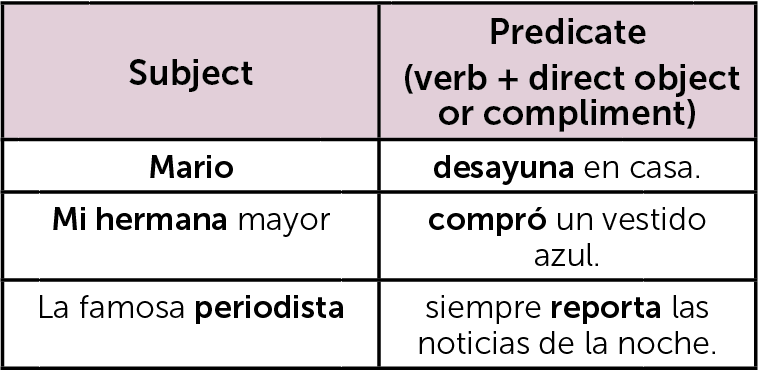Bosque de Palabras
Bosque de Palabras is a text adventure survival game designed to help you learn Spanish vocabulary and grammar while having fun!
In Bosque de Palabras, you're camping️ in the middle of a dark forest, with only a few pieces of food left and a campfire keeping you warm. Every choice you make is important for your survival.
Perfect for: Novice and Intermediate level Spanish learners.
Beginner's Guide to Spanish Sentence Structure With Examples
Gordon Feliz • Updated Jan 21st, 2024


Apprendre en français

Aprender em Português
Table of Contents
-
Lesson
-
Lesson topic 1
-
-
Exercises to practice ___
-
Exercise topic 1
-
-
Additional resources for ___
Spanish, a Romance language, is known for its melodic rhythm and rich linguistic heritage. One key aspect of mastering Spanish is understanding its sentence structure, which might differ from English or other languages. This guide will explore the basics of Spanish sentence structure with clear examples.
1. The Basic Sentence Structure: Subject-Verb-Object (SVO)
Just like in English, a typical Spanish sentence follows the SVO order. However, Spanish is more flexible with sentence structure.
Example 1: "Juan come manzanas." (Juan eats apples.)
Example 2: "Ella escribe una carta." (She writes a letter.)
2. Subject Pronouns Are Often Omitted
In Spanish, the verb conjugations reveal the subject, making the subject pronoun often unnecessary.
Example 1: "Hablo español." (I speak Spanish.)
Example 2: "Comieron en el restaurante." (They ate at the restaurant.)
3. Placement of Adjectives
Unlike English, adjectives in Spanish usually come after the noun they describe, though there are exceptions.
Example 1: "El gato negro duerme." (The black cat sleeps.)
Example 2: "Una casa grande." (A big house.)
4. Use of Reflexive Verbs
Reflexive verbs are common in Spanish and show that the subject performs an action on itself. They are used with reflexive pronouns like "me," "te," "se."
Example 1: "Me lavo las manos." (I wash my hands.)
Example 2: "Se peina el cabello." (He/She combs his/her hair.)
5. Asking Questions
In Spanish, questions can be formed simply by changing the intonation and adding question marks, without the need for rearranging the words as in English.
Example 1: "¿Cómo estás?" (How are you?)
Example 2: "¿Qué hora es?" (What time is it?)
6. Negative Sentences
Negation in Spanish is straightforward, with "no" placed before the verb.
Example 1: "No tengo hermanos." (I do not have siblings.)
Example 2: "Ellos no quieren comer." (They do not want to eat.)
7. Compound Sentences
Compound sentences in Spanish are formed using conjunctions like "y" (and), "o" (or), "pero" (but).
Example 1: "Estudio español pero hablo inglés también." (I study Spanish but I speak English too.)
Example 2: "Quiero ir al cine y ver una película." (I want to go to the cinema and watch a movie.)

Learning Exercises for Sentence Structure
1. Basic Sentence Structure: Subject-Verb-Object (SVO)
"El perro corre rápidamente." - "The dog runs quickly."
"La profesora enseña matemáticas." - "The teacher teaches mathematics."
"Nosotros leemos un libro." - "We read a book."
"El niño bebe agua." - "The boy drinks water."
"María canta una canción." - "Maria sings a song."
2. Subject Pronouns Are Often Omitted
"Vivo en España." - "I live in Spain."
"Trabajan en un banco." - "They work in a bank."
"Estudia por la noche." - "He/She studies at night."
"Cocinamos juntos." - "We cook together."
"Necesita ayuda." - "He/She needs help."
3. Placement of Adjectives
"Un coche rápido." - "A fast car."
"Flores hermosas." - "Beautiful flowers."
"Un hombre inteligente." - "An intelligent man."
"Casas modernas." - "Modern houses."
"Una mujer fuerte." - "A strong woman."
4. Use of Reflexive Verbs
"Nos vestimos rápidamente." - "We get dressed quickly."
"Te cepillas los dientes." - "You brush your teeth."
"Se acuesta temprano." - "He/She goes to bed early."
"Me olvido del nombre." - "I forget the name."
"Se miran en el espejo." - "They look at themselves in the mirror."
5. Asking Questions
"¿Dónde vives?" - "Where do you live?"
"¿Cuántos años tienes?" - "How old are you?"
"¿Por qué estudias español?" - "Why do you study Spanish?"
"¿Cuándo es tu cumpleaños?" - "When is your birthday?"
"¿Quién es tu actor favorito?" - "Who is your favorite actor?"
6. Negative Sentences
"No me gusta el frío." - "I do not like the cold."
"Ella no va a la escuela hoy." - "She is not going to school today."
"No tenemos coche." - "We do not have a car."
"Ellos no entienden la pregunta." - "They do not understand the question."
"No quiero comer ahora." - "I do not want to eat now."
7. Compound Sentences
"Leo un libro y escucho música." - "I read a book and listen to music."
"Quieres café o té?" - "Do you want coffee or tea?"
"Puedo ir al cine pero prefiero quedarme en casa." - "I can go to the cinema but I prefer to stay home."
"Él es rápido pero no muy fuerte." - "He is fast but not very strong."
"Ella estudia biología y física." - "She studies biology and physics."
Additional Resources To Learn More About Spanish Sentence Structure
FluentU Spanish - Spanish Sentence Structure: A Beginner’s Guide [With Examples and Audio]: This guide provides an overview of Spanish sentence structure, including indirect questions, adjective placement, and adverb placement. It is particularly helpful for understanding the nuances of forming sentences in different contexts.
Spanish Academy - A Simple Guide to Spanish Sentence Structure and Order: This article covers various aspects of Spanish sentence structure, such as adjective and adverb placement, and the structure of affirmative, negative, and interrogative sentences. It's useful for understanding the flexibility and rules of word placement in Spanish sentences.
Mango Languages - Spanish sentence structure: a practical guide: This guide provides practical examples of sentence structures, covering topics like prepositional phrases, pronouns, and relative clauses. It's beneficial for learners who want to understand how different sentence elements are used in Spanish.
